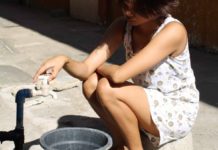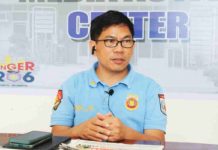[av_one_full first min_height=” vertical_alignment=” space=” custom_margin=” margin=’0px’ padding=’0px’ border=” border_color=” radius=’0px’ background_color=” src=” background_position=’top left’ background_repeat=’no-repeat’ animation=”]
[av_heading heading=’Artists paint on MassKara fest trophies’ tag=’h3′ style=’blockquote modern-quote’ size=” subheading_active=’subheading_below’ subheading_size=’15’ padding=’10’ color=” custom_font=”][/av_heading]
[av_textblock size=” font_color=” color=”]
THEY’RE BACK.
MassKara trophies created and painted by local artists are returning for this year’s festival.
And it’s not just one or nine but 16 artists did the trophies this year.
Dubbed “MassKara 16,” the artists painted on wooden materials created by Charlie Co, the first artist to do handcrafted and hand-painted MassKara trophies in 2006.
Since then, different artists would paint on the same wooden form carved as sun and boat, symbols from the story behind the festival.
The MassKara 16 are JayR Delleva, Hilario Campos III, Susanito Sarnate, Roderick Tijing, Junjun Montelibano, Alan Ong, Mark Espuerta, Daryl Feril, Francine Varcas, Barry Cervantes, Jovito Hecita, Darel Javier, Karina Gonzaga, Frelan Gonzaga, Roedil Geraldo, and Mikiboy Pama.
The 16 artists made a total of 33 trophies that will be awarded to winners of various major MassKara events.
Several of this year’s artists also designed MassKara trophies in previous years when the festival was handled by the Silver MassKara Festival Organization, also this year’s festival organizer.
Festival director Eli Francis Tajanlangit says the trophies are a concrete expression of the support of the local artistic community to the festival.
“We hope to institutionalize this to remind everyone that local artists serve as the soul of this festival,” he says.
(news happy6 caption)
Bacolod City artist Frelan Gonzaga, with the MassKara Festival trophies he painted on. MASSKARA NEWSROOM
Here are the artists’ concepts in their respective paintings:
ALAN ONG. Trophies designed by Ong played with different colors that represent the different barangays of Bacolod. The paper boats represent the travel and journey of the MassKara, while the fish speaks about how the festival goes with the flow.
DARYL FERIL. Feril’s designs look like building blocks. These blocks represent the different personalities that make up a community.
FRANCINE VARCAS. A “sense of earthliness” is what Varcas is going for. She says the colorful festival should not forget the treasures of Negros Island.
BARRY CERVANTES. His design has a hand, a sun and a plant. The hand represents that of an artist and the involvement of art in the festival. The blooming plant represents the progress of the city, while the sun represents the people’s smile amid their struggles.
HILARIO CAMPOS III. A lover of underwater creatures, Campos designed his trophy with coral reefs to represent the colorful MassKara Festival.
DAREL JAVIER. His trophies represent the Bacolodnons crying colorful tears with the same spirit as that of a tiger.
SUSANITO SARNATE. The La Carlota City native’s trophy has a mask in the middle of a sun and a bunch of sugarcane. The mask and the sun represent light and smile, which also equate to hope. The sugarcane represents Bacolod.
FRELAN GONZAGA. The charcoal-like painting on the trophy represents the smiling faces of Bacolodnons, the banderitas represent the festival, while the black-and-white checkered design represent the city.
JUNJUN MONTELIBANO. His design symbolizes the current situation of the country: a person riding a bicycle with a mask on hand and the head covered with an umbrella. The use of the mask is a way of showing others that everything is OK despite the struggles and riding the bicycle shows that whatever happens, everything must keep going. The paint drippings also represent the colorful sheds of blood.
ROEDEL GERALDO. The design is simple: colorful on the front and plain black at the back. Geraldo describes his trophy as a representation of life — that everything must be balanced, like light and darkness.
MIKIBOY PAMA. Pama’s design is very minimal. He only used red and white but highlighted the eyes and the smile. The colors symbolize the political and economic status of the country.
The eyes and the smile were used to show that whatever is happening, sometimes, we just “disregard what we see and smile.” The triangular head also symbolizes the different levels of our society.
JOVITO HECITA. His trophy shows his signature piece as a visual artist, and the mask symbolizes the festival of Bacolod as “The City of Smiles.”
MARK ESPUERTA. Mark’s design represents the people of Bacolod. “Hiding under those masks and smiles are people with hearts of gold,” says Mark. “They are not easily defeated, smiling amidst tragedy, and laughing at struggle and hardships.”
JAYR DELLEVA. The design of trophies he painted symbolizes the people of Bacolod and how they stay happy. He believes that happiness is not the absence of struggles but the ability of dealing and overcoming them.
KARINA GONZAGA. The use of flaglets and the checkered black-and-white, mimicking the Bacolod public plaza, are incorporated with female subjects, which are common in her paintings. “Choosing bright and vivid colors is my way of celebrating life in these dark times. We are a flexible race. We always come out smiling and surviving,” she says.
RODERICK TIJING. According to Roderick, the apple represents success, the eye represents the judge, the ladder represents the struggles and challenges, and the monkey and the pig represent the critics of life waiting for you to fall. To be on top of the ladder, one has to endure the struggles and challenges. (MassKara Newsroom/PN)
[/av_textblock]
[/av_one_full]



